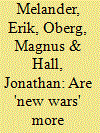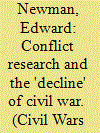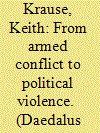|
|
|
Sort Order |
|
|
|
Items / Page
|
|
|
|
|
|
|
| Srl | Item |
| 1 |
ID:
091918


|
|
|
|
|
| Publication |
2009.
|
| Summary/Abstract |
It is widely believed that the human impact of civil conflict in the present era is especially destructive. Proponents of the 'new wars' thesis hold that today's conflicts are fuelled by exclusive identities, motivated by greed in the absence of strong states, and unchecked by the disinterested great powers, resulting in increased battle severity, civilian death and displacement. The ratio of civilian to military casualties is claimed to have tilted, so that the overwhelming majority of those killed today are civilians. Using systematic data that are comparable across cases and over time we find that, contrary to the 'new wars' thesis, the human impact of civil conflict is considerably lower in the post-Cold War period. We argue that this pattern reflects the decline of ideological conflict, the restraining influence of globalization on governments, and the increasing rarity of superpower campaigns of destabilization and counter-insurgency through proxy warfare.
|
|
|
|
|
|
|
|
|
|
|
|
|
|
|
|
| 2 |
ID:
103119


|
|
|
|
|
| Publication |
2009.
|
| Summary/Abstract |
In recent years a number of scholars have suggested that there has been a decline in the absolute numbers of civil wars since the early 1990s, and this claim is purportedly supported by empirical evidence. This paper explores the methodological challenges which confront the study of conflict trends and identifies a number of problems with prevailing approaches. It argues that a differentiated approach to the concept of civil war is necessary before it is possible to make claims about trends in numbers of conflicts, because even the most sophisticated methodological processes have problems related to the manner in which they define and codify armed conflict. Nevertheless, the paper accepts that there has been a decline in the number of major civil wars, and it proposes - and evaluates - a number of explanations for the decline in such wars. These are: the decline of potent ideology since the end of the Cold War, which had hitherto ignited and/or exacerbated armed violence; the decline in intervention by third parties in civil war, a key feature of 'proxy' conflicts during the Cold War; the increasing tendency for secession - or hard partition - to be recognised by the international community, which has defused some ongoing conflicts; the increasingly interventionist nature of peacekeeping and peacebuilding activities by international organisations; the growing tendency for powerful states to view civil war and state failure as a potential security threat, resulting in a more substantial effort to resolve conflict which might have hitherto been regarded as 'merely' a humanitarian issue or even completely ignored; and the growing number of consolidated democracies.
|
|
|
|
|
|
|
|
|
|
|
|
|
|
|
|
| 3 |
ID:
147561


|
|
|
|
|
| Summary/Abstract |
Most contemporary lethal violence does not occur in conflict zones, the majority of states most affected by lethal violence are not at war, and the levels of lethal violence in many nonconflict settings are higher than in war zones. Much of this nonwar violence is organized, not random, and political in nature. A narrow focus on wars and formal armed conflicts thus obscures the high levels of everyday violence and insecurity around the world. This essay makes the case that adopting a broad understanding of political violence – including violence committed by the state and its agents, and nonphysical violence as the violation of basic rights – is essential to gain insight into the causes and consequences of, and to frame appropriate responses to, war and violence in the twenty-first century.
|
|
|
|
|
|
|
|
|
|
|
|
|
|
|
|
|
|
|
|
|